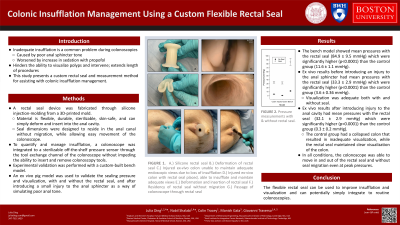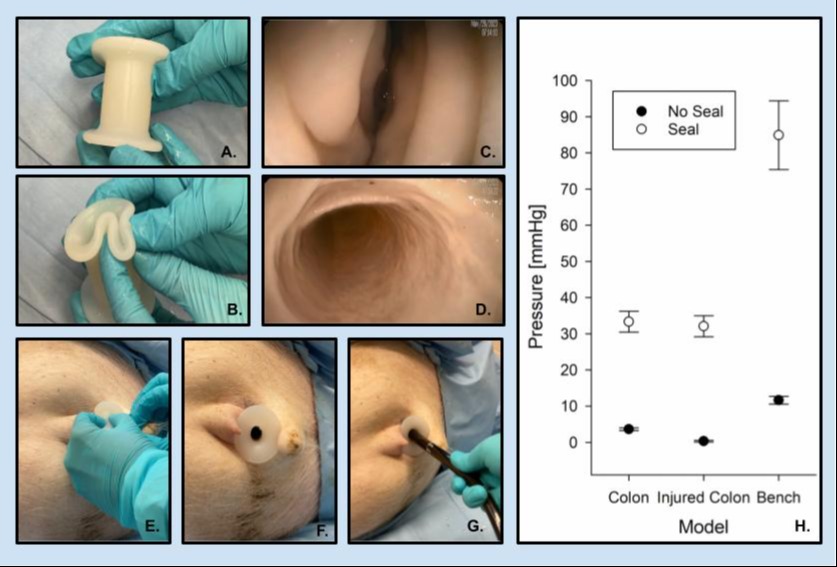Tuesday Poster Session
Category: General Endoscopy
P4102 - Colonic Insufflation Management Using a Custom Flexible Rectal Seal
Tuesday, October 29, 2024
10:30 AM - 4:00 PM ET
Location: Exhibit Hall E

Has Audio
- JD
Julia Ding, MD
Boston Medical Center
Boston, MA
Presenting Author(s)
Julia Ding, MD1, Nabil Shalabi, PhD2, Colin Tracey, 3, Manish Gala, MD4, Giovanni Traverso, MBChB2
1Boston Medical Center, Boston, MA; 2Brigham and Women's Hospital, Cambridge, MA; 3Brigham and Women's Hospital, Boston, MA; 4Massachusetts General Hospital, Boston, MA
Introduction: Inadequate insufflation is a common problem during colonoscopies when patients have poor anal sphincter tone. Gas leakage hinders the ability to visualize polyps while also extending the length of procedures. Furthermore, increase in sedation with propofol can decrease resting anal sphincter tone by half, worsening gas leakage. This study presents a custom rectal seal and measurement method for assisting with colonic insufflation management.
Methods: A rectal seal device was fabricated through silicone injection-molding from a 3D-printed mold. The silicone material is flexible, durable, sterilizable, skin-safe, and can simply deform and insert into the anal cavity. The seal dimensions were designed to reside in the anal canal without migration, while allowing easy movement of the colonoscope. To quantify and manage insufflation, a colonoscope was integrated to a sterilizable pressure sensor through the instrument channel of the colonoscope. Experimental validation was performed with a custom-built chamber where the rectal seal was fitted around a rubber gasket in the chamber lid. Furthermore, an ex vivo pig model was ethically harvested with the anal sphincter still attached to the colon and the model was used to validate the sealing pressure and visualization with and without the rectal seal and after introducing a small injury to the anal sphincter as a way of simulating poor anal tone. Experiments were repeated 6 times in each condition.
Results: The bench model showed mean pressures with the rectal seal (84.9 ± 9.5 mmHg) which were significantly higher (p< 0.0001) than the control group (11.6 ± 1.1 mmHg). Ex vivo results before introducing an injury to the anal sphincter had mean pressures with the rectal seal (33.3 ± 2.9 mmHg) which were significantly higher (p< 0.0001) than the control group (3.6 ± 0.36 mmHg). In both cases, visualization was adequate and clear. After introducing an injury to the anal cavity, mean pressures held with the rectal seal (32.1 ± 2.9 mmHg), and were significantly higher (p< 0.0001) than the control group (0.3 ± 0.2 mmHg). The control group had a collapsed colon that resulted in inadequate visualization, while the rectal seal maintained clear visualization of the lumen. In all conditions, the colonoscope was able to move in and out of the rectal seal and without seal migration even at peak pressures.
Discussion: The flexible rectal seal can be used to improve insufflation and visualization and can potentially simply integrate to routine colonoscopies.

Disclosures:
Julia Ding, MD1, Nabil Shalabi, PhD2, Colin Tracey, 3, Manish Gala, MD4, Giovanni Traverso, MBChB2. P4102 - Colonic Insufflation Management Using a Custom Flexible Rectal Seal, ACG 2024 Annual Scientific Meeting Abstracts. Philadelphia, PA: American College of Gastroenterology.
1Boston Medical Center, Boston, MA; 2Brigham and Women's Hospital, Cambridge, MA; 3Brigham and Women's Hospital, Boston, MA; 4Massachusetts General Hospital, Boston, MA
Introduction: Inadequate insufflation is a common problem during colonoscopies when patients have poor anal sphincter tone. Gas leakage hinders the ability to visualize polyps while also extending the length of procedures. Furthermore, increase in sedation with propofol can decrease resting anal sphincter tone by half, worsening gas leakage. This study presents a custom rectal seal and measurement method for assisting with colonic insufflation management.
Methods: A rectal seal device was fabricated through silicone injection-molding from a 3D-printed mold. The silicone material is flexible, durable, sterilizable, skin-safe, and can simply deform and insert into the anal cavity. The seal dimensions were designed to reside in the anal canal without migration, while allowing easy movement of the colonoscope. To quantify and manage insufflation, a colonoscope was integrated to a sterilizable pressure sensor through the instrument channel of the colonoscope. Experimental validation was performed with a custom-built chamber where the rectal seal was fitted around a rubber gasket in the chamber lid. Furthermore, an ex vivo pig model was ethically harvested with the anal sphincter still attached to the colon and the model was used to validate the sealing pressure and visualization with and without the rectal seal and after introducing a small injury to the anal sphincter as a way of simulating poor anal tone. Experiments were repeated 6 times in each condition.
Results: The bench model showed mean pressures with the rectal seal (84.9 ± 9.5 mmHg) which were significantly higher (p< 0.0001) than the control group (11.6 ± 1.1 mmHg). Ex vivo results before introducing an injury to the anal sphincter had mean pressures with the rectal seal (33.3 ± 2.9 mmHg) which were significantly higher (p< 0.0001) than the control group (3.6 ± 0.36 mmHg). In both cases, visualization was adequate and clear. After introducing an injury to the anal cavity, mean pressures held with the rectal seal (32.1 ± 2.9 mmHg), and were significantly higher (p< 0.0001) than the control group (0.3 ± 0.2 mmHg). The control group had a collapsed colon that resulted in inadequate visualization, while the rectal seal maintained clear visualization of the lumen. In all conditions, the colonoscope was able to move in and out of the rectal seal and without seal migration even at peak pressures.
Discussion: The flexible rectal seal can be used to improve insufflation and visualization and can potentially simply integrate to routine colonoscopies.

Figure: Figure 1. A.) Silicone rectal seal B.) Deformation of rectal seal C.) Injured ex-vivo colon unable to maintain adequate endoscopic views due to loss of insufflation D.) Injured ex-vivo colon with rectal seal placed, able to insufflate and maintain adequate views E.) Deformation and insertion of rectal seal F.) Residency of rectal seal without migration G.) Passage of colonoscope through rectal seal H.) Pressure measurements with and without rectal seal.
Disclosures:
Julia Ding indicated no relevant financial relationships.
Nabil Shalabi indicated no relevant financial relationships.
Colin Tracey indicated no relevant financial relationships.
Manish Gala indicated no relevant financial relationships.
Giovanni Traverso indicated no relevant financial relationships.
Julia Ding, MD1, Nabil Shalabi, PhD2, Colin Tracey, 3, Manish Gala, MD4, Giovanni Traverso, MBChB2. P4102 - Colonic Insufflation Management Using a Custom Flexible Rectal Seal, ACG 2024 Annual Scientific Meeting Abstracts. Philadelphia, PA: American College of Gastroenterology.

